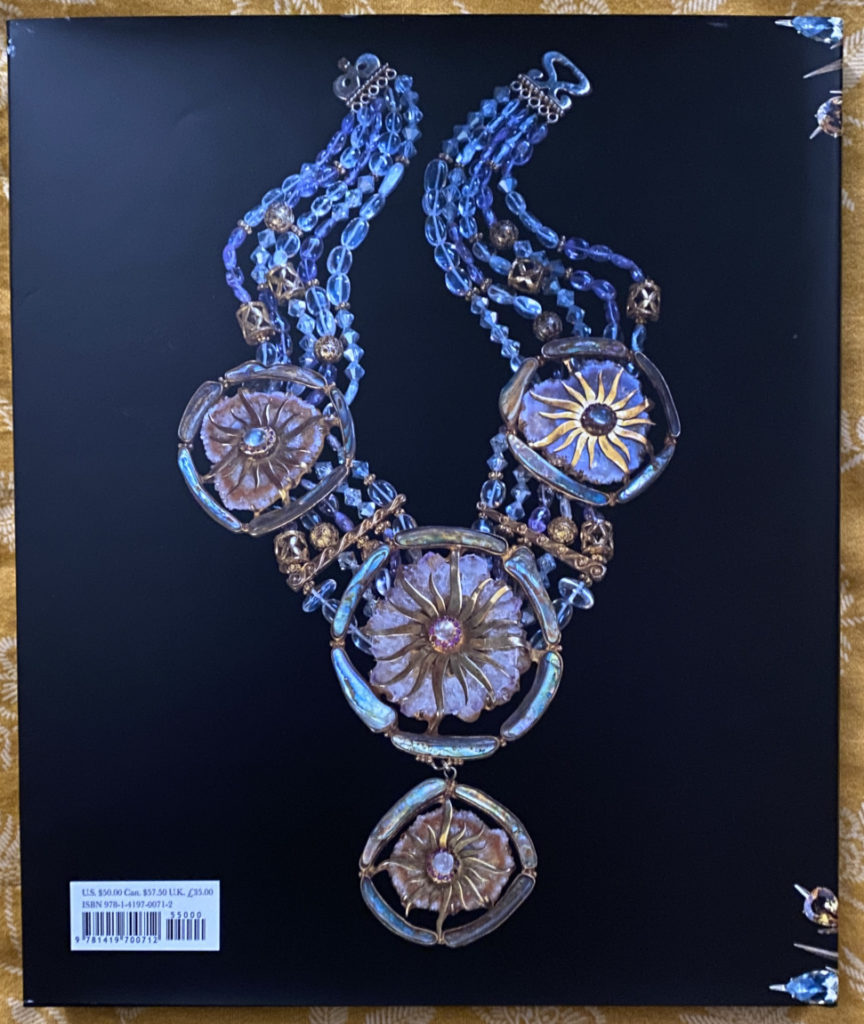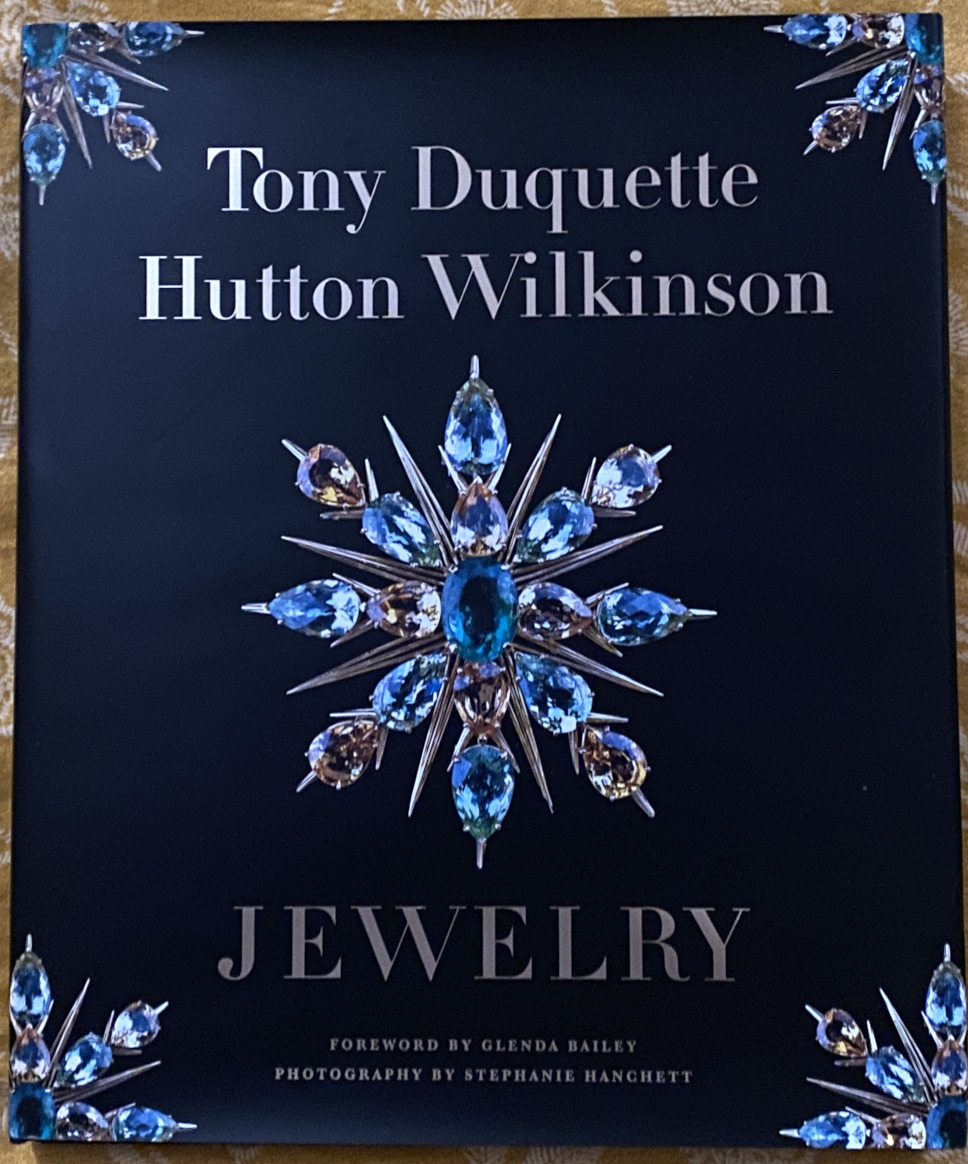“…jewels are beautiful for the element of fantasy that they contain, not for the price our society puts upon them… it is beauty, not luxury, that I value…” Tony Duquette (the very first quote in the book this article is based upon, on the inside of the dust jacket)
Tony Duquette is most famous for his interior design business that he started in 1941 in California. Googling him you can see loads of pictures of opulent rooms in signal colours, heavily laden with golden and shimmering decoration. Some look like you would imagine the interior of a Chinese palace from the imperial period. He was completely unafraid to mix patterns with other patterns and various colours and add lots of accessories for good measure. I can imagine having one room in a villa or castle decorated by him to get the colour flash, like in former centuries kings and queens had one “Japanese” or “Chinese” room in their palace.
A full house as colourful as this is certainly daring. Tony Duquette designed one for himself, Dawnridge Estate, which is today owned and used as a home by his student and heir, Hutton Wilkinson. If you live in an antique palace or a museum, it probably becomes normal at some point. When looking from the outside, though, the challenge seems tough. The whole design doesn’t feel like it is there to be used and comfortable to live in, but to show it off. Comfort does take second row to presentability.
There is no surprise that Tony Duquette did work for the great movie companies of 1950s’ Hollywood quite often and his decorations for film sets became legendary. His private customers included the Duchess of Windsor, Doris Duke, Elizabeth Arden, James Coburn and many more. One of the first really famous American interior designers, Elsie de Wolfe, Lady Mendl, pushed Duquette’s career relentlessly.
Hutton Wilkinson set Tony Duquette’s interior design an enduring memorial through 3 books, “Tony Duquette” (2007), “More is more: Tony Duquette” (2009) and “Tony Duquette’s Dawnridge” (2018).
Hutton Wilkinson started to work for Tony Duquette at the age of 18 in 1971 and later became his business partner. In 1999 he became his heir. The two men and their wives got on perfectly well. Luck struck with those two couples. It must be wonderful to find an heir who continues your work and it is extraordinary to find a mentor who supports you all the way up. Very good karma indeed.
A full house in the Duquette style might be a bit much for tender spirts, but his jewellery is not. It is colourful, opulent, sparkling, unexpected and surprising.
Wearing one piece, a brooch or earrings or a necklace or a bracelet gives enough colour and light to make a simple outfit shining. Tony Duquette and Hutton Wilkinson used bold stones or bold combination of stones or bold combination of stones mixed with other materials. Stones included precious and semi-precious ones and other materials stood for pearls, corals, even ceramics and little fossil stones.

On the front cover and the back cover of the book are examples of their jewellery. Whilst the brooches on the front cover are of the tamer variety, the luminous necklace on the back cover does give an impression of what his art is about. Abalone pearls, gold and a wild mix of colourful, semi-precious stones find together to a wonderful statement piece.
Inside the book are beautiful examples of red coral combinations with pearls and colourful stones inlaid with other stones… Duquette’s creativity was boundless.
Whilst not all the stones are of the expensive kind, the full piece of art is – checking the internet for Tony Duquette jewellery shows prices in the high five-digit numbers. The company website only gives prices on demand.
Some of the pieces do have a similar look as the ones you can buy today in specialty shops for semi-precious-stone jewellery set in silver in various countries around Europe. I have seen such shops in Florence, Munich, Nice, Vienna and many other cities. There are also minerals fairs, although greatly diminished after Corona, from smaller local ones to Baselworld, that has also sadly been discontinued. The items there are generally not as perfectly made as Tony Duquette’s, but the colour explosion comes sometimes close. And the prices are not ruining anyone. There is always the chance to ask a local jeweller to put the finishing touches on.
It is great that a bird of paradise like Tony Duquette founded and retained a profitable business. It is even better his legacy lives on and his creativity is continued by the next generation.
There will be always those who draw strength trough visual beauty. The eye is a powerful gate to the soul and heart of human beings. The eye must be allowed to feast on colour, be it though nature or through a jewel. A picture in a book has the same effect as looking at the real thing. The head clears of worries and the dreaming starts.
It is exactly as in Tony Duquette’s quote at the beginning of the article. The beauty of jewels it not about wealth or the price tag attached, but about the buttons they push in our fantasy.
All rights to the book belong to:
Wilkinson, Hutton, 2011: Tony Duquette jewelry / Hutton Wilkinson, foreword by Glenda Bailey, photography by Stephanie Hanchett, published by Abrams, in imprint of ABRAMS, 115 West 18th Street, New York, NY 10011, printed and bound in China, ISBN: 978-1-4197-0071-2

